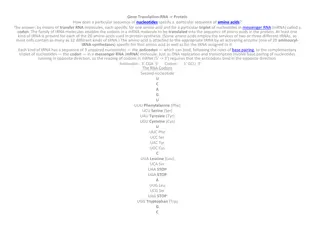Role of RNA in Biological Processes and Protein Synthesis
Ribonucleic acid (RNA) is a crucial polymeric molecule in various biological functions including coding, decoding, gene regulation, and expression. It works alongside DNA and plays a key role in protein synthesis. There are three major types of RNA - rRNA, tRNA, and mRNA, each with specific functions in the process. RNA can also catalyze reactions, control gene expression, and respond to cellular signals. Understanding the structure and functions of RNA sheds light on its importance in the molecular machinery of life.
Uploaded on Oct 09, 2024 | 0 Views
Download Presentation

Please find below an Image/Link to download the presentation.
The content on the website is provided AS IS for your information and personal use only. It may not be sold, licensed, or shared on other websites without obtaining consent from the author.If you encounter any issues during the download, it is possible that the publisher has removed the file from their server.
You are allowed to download the files provided on this website for personal or commercial use, subject to the condition that they are used lawfully. All files are the property of their respective owners.
The content on the website is provided AS IS for your information and personal use only. It may not be sold, licensed, or shared on other websites without obtaining consent from the author.
E N D
Presentation Transcript
2. Ribonucleic acid (RNA) Ribonucleic acid (RNA) is a polymeric molecule essential in various biological roles in coding, decoding, regulation, and expression of genes. RNA and DNA are nucleic acids, and, along with lipids, proteins and carbohydrates, constitute the four major macromolecules essential for all known forms of life. Like DNA, RNA is assembled as a chain of nucleotides, but unlike DNA it is more often found in nature as a single-strand folded onto itself, rather than a paired double-strand. Cellular organisms use messenger RNA (mRNA) to convey genetic information (using the nitrogenous bases of guanine, uracil, adenine, and cytosine, denoted by the letters G, U, A, and C) that directs synthesis of specific proteins. Many viruses encode their genetic information using an RNA genome.
Structure of RNA There are three major types of RNA that participate in the process of protein synthesis: rRNA, tRNA, and mRNA. Like DNA, these three types of RNA are unbranched polymeric molecules composed of nucleoside monophosphate s joined together by 3' 5'-phosphodiester bonds. However, they differ from DNA in several ways. For example, they are considerably smaller than DNA, contain ribose instead of deoxyribose and uracil instead of thymine, and exist as single strands that are capable of folding into complex structures. The three major types of RNA also differ from each other in size, function, and special structural modifications.
Some RNA molecules play an active role within cells by catalyzing biological reactions, controlling gene expression, or sensing and communicating responses to cellular signals. One of these active processes is protein synthesis, a universal function where RNA molecules direct the assembly of proteins on ribosomes. This process uses transfer RNA (tRNA) molecules to deliver amino acids to the ribosome, where ribosomal RNA (rRNA) then links amino acids together to form proteins.























